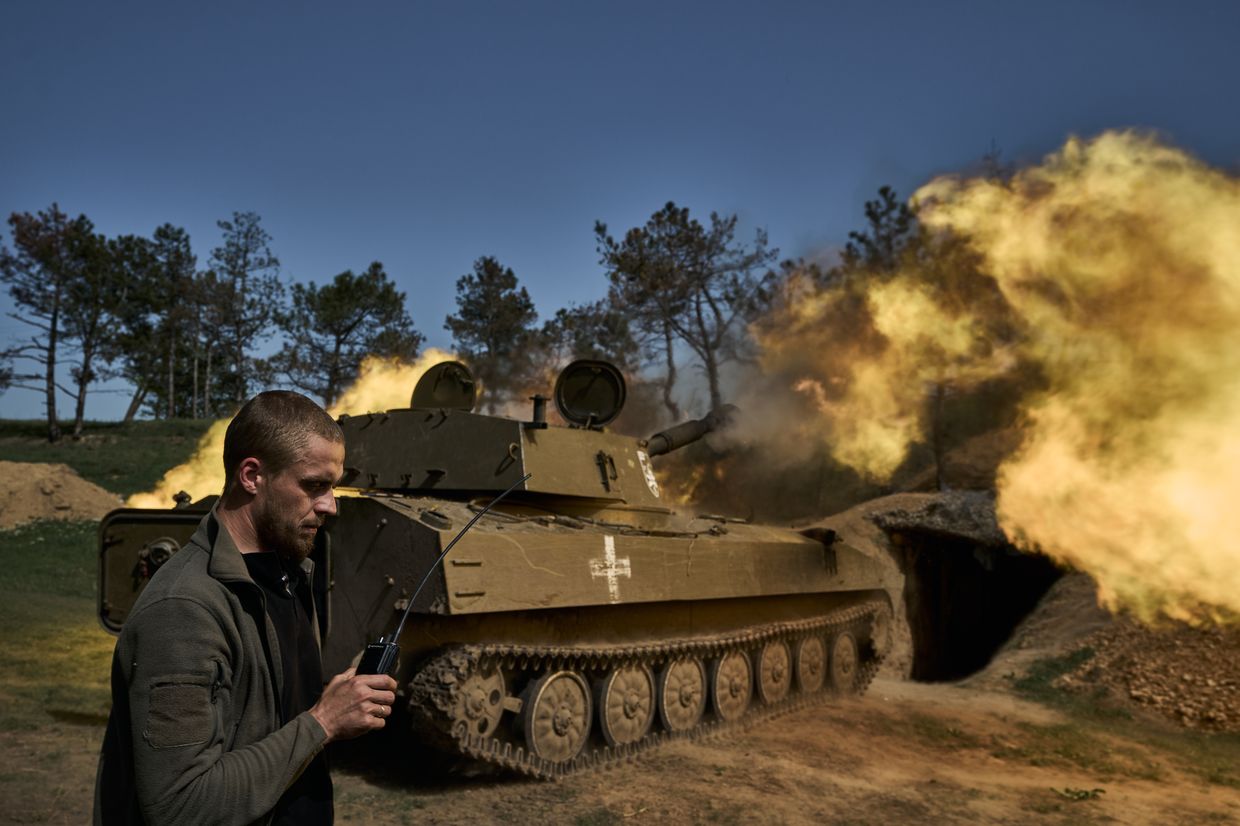
Russia’s Toretsk offensive: Another Donbas town could fall as West delays weapons talks
Russia’s grinding Donbas ground offensive makes fresh gains as Ukraine’s Western allies delay Ramstein airbase meeting key to securing more weaponry
In this aerial drone image, damage to the city and its buildings can be seen after heavy artillery and guided bomb attacks by Russia in Toretsk, Ukraine, on July 24, 2024. Residents of Toretsk have fled the town in recent weeks as Russia has escalated its attacks in the area. (Kostiantyn Liberov/Libkos/Getty Images)
Russia’s invading army is racing against the weather clock, trying to seize yet more towns in Ukraine’s eastern Donbas region before the ground gets muddy this autumn and temperatures later plunge.
The coal mining town of Toretsk is on the verge of falling to Moscow’s forces, an outcome which would make it the latest in a handful of towns and villages falling in recent months to Russia’s grinding Donbas offensive launched a year ago.
“I don’t think the town will hold out for long,” said Ukrainian artilleryman Oleksandr with the 109th Territorial Defense Brigade deployed in the area, stressing that there is a “serious shortage of people.”
Fierce house-to-house fighting rages in Toretsk, a Ukrainian stronghold since Russia’s first invasion of Donbas in 2014 following the occupation of Crimea. For most of the first two years of Russia’s full-scale invasion launched in early 2022, it was tucked away in a calmer part of the front line until Russian forces started storming it this June.
“The situation is very bad, and if our command doesn't send reserves there in the nearest future, the situation would be very difficult, if not catastrophic,” Ukrainian military expert Mykhailo Zhyrokhov told the Kyiv Independent.
"The situation is very bad, and if our command doesn't send reserves there in the nearest future, the situation would be very difficult, if not catastrophic."
“We are now in autumn, and the Russians understand that when the weather changes and it becomes impossible to organize logistics, their offensive will stop. So while the weather is more or less okay, they are trying to capture as much as possible,” he added.
The Ukrainian military has admitted that the situation in Toretsk, where some 1,200 civilians remain, is deteriorating. Russian troops have entered Toretsk’s eastern outskirts and are trying to move toward the central mine in the western part of the town, military spokeswoman Anastasia Bobovnikova reported on Oct. 7.


According to Oleksandr and military analysts interviewed, the fate of Toretsk depends on whether Ukraine can allocate reserve units and scarce artillery shells to prevent a further Russian advance. Ukraine is often forced to prioritize some sectors of the front line more than others due to a severe shortage of resources — from ammunition to equipment and manpower.
Earlier this month, Ukraine lost Vuhledar, another mining town located 80 kilometers southwest of Toretsk in Donetsk Oblast.
The deepening Russian advance comes as Ukraine scrambles to secure as many resources and weapons as possible for its troops before the uncertain U.S. presidential election.
The regular Ukrainian Defense Contact Group meeting meant to gather leaders of 50-plus countries to discuss further Ukraine aid this weekend at Ramstein airbase in Germany, was postponed due to outgoing U.S. President Joe Biden’s cancellation of his Europe trip this week. Biden put off the visit due to a hurricane hammering the southern state of Florida.
"As winter approaches, we need support," Ukrainian President Volodymyr Zelensky told his French counterpart Emmanuel Macron on Oct. 10 during a meeting in Paris. Zelensky spoke while on tour, taking the opportunity of the Ramstein meeting being canceled to travel to European capitals to rally support for boosting weaponry supplies to his country.
Earlier in the day, Zelensky held talks in London with U.K. Prime Minister Keir Starmer and NATO Secretary General Mark Rutte.
Some Ukrainian soldiers expressed their concerns that the instability of Western military aid makes it extremely difficult for Kyiv to plan on the battlefield.
“There is no possibility of good planning ... because we are very dependent on our allies,” said Anton, an acting commander of a reconnaissance platoon with the 112th Territorial Defense Force Brigade deployed in southeastern Zaporizhzhia Oblast.
“We are fighting here today and now. And what will happen tomorrow is unknown. Maybe we can hold those positions, but if there will be no artillery shells, these positions will be lost very quickly.”

For Oleksandr, who is defending the Ukrainian-controlled parts of Toretsk, the ammunition shortage in his unit has worsened since April, leaving insufficient amounts to target all Russian positions.
He said that his artillery battery, which operates on four different weapon systems, only receives enough shells to shoot five to ten times daily. And compared to a few months ago when Russian troops were only trying to advance where they saw the opportunities, “they are heavily trying to assault” Ukrainian defense positions in the area, he added.
The Russian military has increasingly become better at exploiting weak spots to overwhelm Ukrainian defenses with a massive quantity of troops and firepower. Moscow accelerated its push on Toretsk after capturing Vuhledar earlier in October, advancing deeper into the central part of Donetsk Oblast nearly five months after it took advantage of a poorly organized Ukrainian rotation of units to penetrate through the 2014 defense in May.
Besides Toretsk, the current hottest spots of the war are the Pokrovsk and Kurakhove sectors west and southwest of Toretsk. However, there are signs that Russia may begin a new push elsewhere to further stretch Ukrainian troops, according to Western and Ukrainian military experts.

Emil Kastehelmi, an analyst at the Finland-based Black Bird Group, which has provided detailed coverage of the war from open sources, said Ukraine faces a difficult balancing act between its ability to replace casualties with fresh troops while trading “as little ground as possible in order to inflict heavy casualties to the Russians.”
“It’s always about trading land for (Russian) casualties in this situation,” Kastehelmi said. “Ukrainian commanders need to carefully always consider what position to leave in order to spare some of their own troops, but not to let the Russians into too favorable positions.”
Russia’s Donbas offensive, which has cost them, according to various estimates, hundreds to more than a thousand troops per day over the past year, has “been really, really expensive and a long process,” Kastehelmi said.
“If all places take this long and cost this much, the Russians won’t be able to achieve any of their goals in the war,” Kastehelmi added, referring to the Russian army’s two-year-long attempts to capture Vuhledar.
Since Russia began a large-scale offensive on Avdiivka one year ago, relying on a seemingly endless wave of battalion-sized mechanized assaults, it has held the initiative across most of the battlefield, albeit at a massive cost in terms of losses.
After capturing the small industrial city just outside Russian-occupied Donetsk in February, Moscow’s troops have toppled over scores of villages to almost reach the key logistic artery connecting the lower and upper parts of Donetsk Oblast — and thereby threatening the roadway junction and supply line city of Pokrovsk.
When Ukraine launched a surprise cross-border incursion into Russia’s Kursk Oblast in August, Moscow took advantage of Kyiv’s attention shift to the northeast by intensifying attacks on Pokrovsk. Russian troops are now less than 10 kilometers from the key logistic hub that connects the last Ukrainian-held eastern strongholds with the cities westward.
Despite Russia’s proximity to Pokrovsk compared to the 15 kilometers-distance it was at before the Kursk incursion, military analysts told the Kyiv Independent that Ukraine appears to have stabilized the front line for now, and the defense lines appear prepared.
About 30 kilometers southward, another worrying situation is developing around Kurakhove, which hosts a large reservoir. Russian troops are less than five kilometers from the town, trying to further solidify the northern and southern flanks to threaten encirclement.
However, a far more serious full encirclement threat is unfolding to the northeast of Kurakhove.
Russian troops surround a Ukrainian pocket along both banks of the Vovcha River from three sides. The pocket is only roughly eight kilometers from being completely encircled. However, experts are confident that Ukraine could withdraw on time when the situation becomes critical, given that it is a field, and retreating would not be too hard.
Further south, Russia appears to be preparing for a further push upwards after capturing Vuhledar earlier in October. Vuhledar was important as it served as an intersection between the front lines of Donetsk and southeastern Zaporizhzhia oblasts, according to Serhiy Zgurets, director of the Ukrainian information and consulting company Defense Express.

The Ukrainian military has reported since late September that Russia may begin a push in Zaporizhzhia Oblast, and has begun limited assault operations to pressure Ukrainian defenses there.
“(Russian troops) are now trying to activate actions in the southern direction to again create conditions to stretch our reserves (in an area of the front line that was calmer),” Zgurets said.
Before Russia’s capture of Vuhledar, Ukrainian troops used artillery to threaten Moscow’s logistics on parts of Highway H20 in Russian-occupied territories that lead up to cities further south like Volnovakha and Mariupol, Zgurets explained. The town is also important to Moscow as it is located at a height, allowing Moscow to form a “reliable transport corridor” for its troops in Zaporizhzhia Oblast, he added.
Kastehelmi from the Black Bird Group said there are signs that Russia may be intensifying its push in areas like near Siversk in the northern part of Donetsk Oblast.
The Russian Defense Ministry said on Oct. 4 that it captured the village of Verkhnokamianske, a claim neither confirmed nor refuted by Ukraine. There may have been “possible developments” in the Siversk area. Still, it is unclear whether they are small Russian reconnaissance groups or whether Russian forces have been able to secure gains there.
“When a country is fighting an attritional war, gradual gains can, of course, develop into rather sudden developments,” Kastehelmi said. “So, it's possible that the defenses can start crumbling more quickly. In a certain sector, we aren't seeing that yet, but it's not impossible.”
“If the Russians are able to replenish their own losses at a quick pace, and if the Ukrainians are still burdened by the current problems regarding equipment, manpower and so on, then the situation can become such that there the Russians may be able to advance more quickly in some sectors.”
But for now, all eyes remain on Toretsk as the Russians advance deeper into the town.
“It is clear that we would lose (Toretsk) in the nearest days,” and it is extremely difficult to hold the defense with the current quantity of troops and resources as the Russian troops advance along its Central Street, according to Zhyrokhov.
Other experts, including the Black Bird Group's Kastehelmi, are more skeptical of Moscow's offensive capability.
Kastehelmi said that the battle of Toretsk could carry on into Winter at the current pace and finds it "unlikely that the Russians will be able to capture the whole city during the next couple of autumn months."
The Kyiv Independent’s News Editor Chris York contributed to this report.














